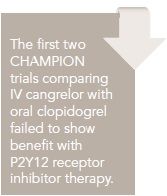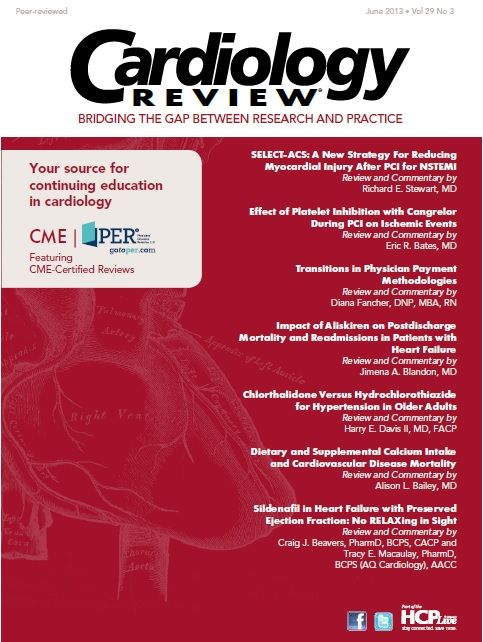Publication
Article
Cardiology Review® Online
Effect of Platelet Inhibition with Cangrelor During PCI on Ischemic Events

Eric R. Bates, MD
Review
Bhatt DL, Stone GW, Mahaffey KW, et al. Effect of platelet inhibition with cangrelor during PCI on ischemic events. N Engl J Med. 2013;368:1303-1313.
Dual antiplatelet therapy with aspirin and a platelet adenosine diphosphate (ADP) P2Y12 receptor inhibitor is recommended therapy for patients undergoing percutaneous coronary intervention (PCI) because of proven benefit in reducing PCI-related ischemic complications. Unfortunately, the antiplatelet effects of oral agents are delayed because of gastrointestinal absorption issues, so preloading is recommended when possible. Additionally, clopidogrel requires hepatic metabolism to produce its active metabolite, delaying achievement of therapeutic blood levels by several hours. Moreover, clopidogrel hyporesponsiveness occurs in approximately 25% of patients, and average platelet inhibition is modest. Recovery of platelet function after cessation of oral antiplatelet therapy takes days; surgery is not recommended for 5 to 7 days after discontinuation.

Cangrelor is an intravenous (IV), potent P2Y12 receptor inhibitor with rapid onset and offset. It was initially studied in patients with acute coronary syndrome (ACS) undergoing PCI in 2 phase 3 trials. In the Cangrelor versus Standard Therapy to Achieve Optimal Management of Platelet Inhibition (CHAMPION) PCI trial,1 cangrelor was compared with clopidogrel administered before PCI in 8,877 patients. In the CHAMPION PLATFORM trial,2 cangrelor was compared with clopidogrel administered after PCI in 5362 patients. Neither trial showed a significant difference between drugs in the primary efficacy composite end point of death, myocardial infarction (MI), or ischemia- driven revascularization at 48 hours.
Study Details
Now comes CHAMPION PHOENIX,3 a randomized, double-blind, double-dummy, placebo-controlled, 153-center international trial that enrolled 11,145 patients undergoing elective or urgent PCI. After randomization and before PCI, patients received either an infusion of cangrelor (30 μg/kg bolus, followed by a 4 μg/kg/min infusion for at least 2 hours or the duration of the procedure, whichever was longer) or 600 mg or 300 mg clopidogrel. At the end of the infusion, the cangrelor group received 600 mg clopidogrel. Aspirin and clopidogrel 75 mg/d were also administered. Choice of periprocedural anticoagulant was at the discretion of the investigator. Glycoprotein (GP) IIa/IIIb inhibitors were allowed only for new or persistent thrombus formation, slow or no reflow, side-branch compromise, dissection, or distal embolization. Arterial sheath management was at the discretion of the investigator.
The primary efficacy end point was a composite of death, MI, ischemia-driven revascularization, or stent thrombosis at 48 hours after randomization in the 10,942 patients who underwent PCI and received the study drug. The primary safety end point was GUSTO severe bleeding at 48 hours not related to coronary artery bypass graft surgery (CABG) in the 11,056 patients who received the study drug. Compared with clopidogrel, the primary composite efficacy end point was lower with cangrelor (4.7% vs 5.9%; adjusted odds ratio [OR], 0.78; P = 0.005), while the primary safety end point was similar (0.16% vs 0.11%; OR, 1.50; P = 0.44). Death rates were identical and ischemia-driven revascularization rates were not different (0.5% vs 0.7%). Stent thrombosis (0.8% vs 1.4%; OR = 0.62; P = 0.01) and MI (3.8 vs 4.7%; OR, 0.8; P = 0.02) rates were lower with cangrelor, producing the benefit in the efficacy composite end point. The number needed to treat with cangrelor to prevent 1 primary end point event was 84 (95% confidence interval [CI], 49-285). At 30-day follow-up, the efficacy benefit was sustained (6.0% vs 7.0%; OR, 0.85; P = 0.03).
CommentaryThe Third Time Was a Charm
The results of the first 2 CHAMPION trials comparing IV cangrelor with oral clopidogrel failed to show benefit with more rapid, more potent P2Y12 receptor inhibitor therapy.1,2 However, a reanalysis of the combined data using the universal definition of MI, rather than the initial protocol definition, suggested an 18% reduction in the efficacy composite end point with cangrelor (3.1% vs 3.8%; P = 0.037), as well as a reduction in stent thrombosis (0.2% vs 0.4%; P = 0.018).4 Therefore, a third trial was pursued with protocol modifications.5 In CHAMPION PHOENIX,3 patients had to be P2Y12 receptor-inhibitor naïve and undergo PCI. The universal definition for MI was used and the stent thrombosis definition was expanded and added to the efficacy composite end point.
Moreover, by including patients with stable coronary artery disease (56%), it was easier to accurately detect periprocedural MI events that otherwise would have been difficult to diagnose in patients with elevated biomarkers from MI. The third time was a charm: cangrelor reduced the rate of ischemic events, including stent thrombosis, without a significant increase in severe bleeding. The statistical difference is more impressive than the actual difference in event rates because of sample size.
In this trial, there was no time for clopidogrel preloading. It should be noted that an IV bolus of cangrelor exerts its potent antiplatelet effect almost immediately, whereas it takes 2 to 6 hours for the oral loading dose of clopidogrel to achieve moderate P2Y12 receptor inhibition. Also, an inferior clopidogrel loading dose of 300 mg was given to 25% of patients, and 37% in the clopidogrel group received the drug during or after PCI. Since most of the benefit with cangrelor was due to a reduction in periprocedural MI within 2 hours of randomization, it could be argued that maximal cangrelor effect was compared with minimal clopidogrel effect in this study. Earlier clopidogrel treatment probably would have attenuated the benefit seen with cangrelor.
A prior pharmacodynamic study suggested possible challenges when coadministering cangrelor and clopidogrel.6 First, when the antiplatelet agents were given simultaneously, there was no inhibition of the P2Y12 receptor after the infusion was stopped because the clopidogrel active metabolite was unavailable for binding due to its short half-life. When clopidogrel was started at the time the cangrelor infusion was discontinued, there was inhibition of the P2Y12 receptor. Therefore, it is important to administer these agents sequentially, as was done in the 3 CHAMPION trials, rather than simultaneously. Second, because of the delayed onset of action of clopidogrel, a theoretical vulnerable period might occur between cangrelor offset and therapeutic clopidogrel activity. It is reassuring that there was no mention of an increase in ischemic events during the transition from cangrelor to clopidogrel in this study, but this needs to be confirmed.
Acute coronary syndromes were present in 44% of the patients in CHAMPION PHOENIX. Ticagrelor and prasugrel have been shown to be superior to clopidogrel in this patient subgroup,7,8 producing a similar reduction in stent thrombosis and periprocedural ischemic events as seen with cangrelor in this study. Therefore, before cangrelor can be recommended for patients with ACS, superiority needs to be proved against ticagrelor and prasugrel in a randomized trial. Also, the cost of periprocedural dosing with ticagrelor or prasugrel is inexpensive. By comparison, the wholesale price is approximately $1,000 for bivalirudin and approximately $650 for an eptifibatide bolus plus infusion in most patients. Costs are higher in very overweight patients, who need an additional drug vial. Do not be surprised if cangrelor costs hundreds of dollars to administer if it is approved for use.
Concern about the administration and absorption of oral antiplatelet agents in patients with ACS has been raised.4 Nausea or vomiting, poor gastrointestinal blood flow, or respiratory or hemodynamic compromise are factors that would favor IV drug administration. Delayed onset of action may even be an issue for prasugrel and ticagrelor.9 Therefore, CHAMPION PHOENIX suggests that cangrelor may have significant benefit in patients who undergo PCI where oral administration of antiplatelet drugs is problematic or preloading is not possible. However, we already have an IV antiplatelet drug option with GP IIb/IIIa inhibitor agents.
The bolus plus infusion strategy for these drugs was required in the pre-stent era to prevent acute closure after balloon angioplasty, and is associated with increased bleeding complications. In the stent era, it has been suggested that only periprocedural GP IIb/ IIIa inhibitor administration is necessary,10 a strategy that would decrease cost and bleeding risk and be competitive with a periprocedural cangrelor strategy. Also, the advantage of bivalirudin monotherapy over unfractionated heparin plus GP IIb/IIIa therapy in PCI may be obviated by radial access. Therefore, if cangrelor is approved for clinical use, it may have to compete against the strategy of unfractionated heparin and bolus-only GP IIb/IIIa inhibitor therapy (wholesale cost, approximately $330). A strategy of bivalirudin plus cangrelor would probably be cost prohibitive.
References
1. Harrington RA, Stone GW, McNulty S, et al. Platelet inhibition with cangrelor in patients undergoing PCI. N Engl J Med. 2009;361:2318- 2329.
2. Bhatt DL, Lincoff AM, Gibson CM, et al. Intravenous platelet blockade with cangrelor during PCI. N Engl J Med. 2009;361:2330-2341.
3. Bhatt DL, Stone GW, Mahaffey KW, et al. Effect of platelet inhibition with cangrelor during PCI on ischemic events. N Engl J Med. 2013;368:1303-1313.
4. White HD, Chew DP, Dauerman HL, et al. Reduced immediate ischemic events with cangrelor in PCI: a pooled analysis of the CHAMPION trials using the universal definition of myocardial infarction. Am Heart J. 2012;163:182-190.
5. Leonardi S, Mahaffey KW, White HD, et al. Rationale and design of the Cangrelor versus standard therapy to acHieve optimal Management of Platelet InhibitiON PHOENIX trial. Am Heart J. 2012;163:768-776.
6. Steinhubl SR, Oh JJ, Oestreich JH, et al. Transitioning patients from cangrelor to clopidogrel: pharmacodynamic evidence of a competitive effect. Thromb Res. 2008;121:527-534.
7. Wiviott SD, Braunwald E, McCabe CH, et al. Prasugrel versus clopidogrel in patients with acute coronary syndromes. N Engl J Med. 2007;357:2001-2015.
8. Wallentin L, Becker RC, Budaj A, et al. Ticagrelor versus clopidogrel in patients with acute coronary syndromes. N Engl J Med. 2009;361:1045- 1057.
9. Parodi G, Valenti R, Bellandi B, et al. Comparison of prasugrel and ticagrelor loading doses in ST-segment elevation myocardial infarction patients. J Am Coll Cardiol. 2013;61:1601-1606.
10. Fung AY, Saw J, Starovoytov A, et al. Abbreviated infusion of eptifibatide after successful coronary intervention. The BRIEF-PCI (Brief Infusion of Eptifibatide Following Percutaneous Coronary Intervention) randomized trial. J Am Coll Cardiol. 2009;53:837-845.
About the Author
Eric R. Bates, MD, is Professor of Internal Medicine at the University of Michigan. Dr. Bates graduated from the University of Michigan Medical School, where he trained in internal medicine and cardiology. His research efforts have focused on fibrinolytic and catheterbased reperfusion therapy for acute MI and cardiogenic shock, antiplatelet and anticoagulant therapy for coronary thrombosis, and coronary artery revascularization. He was vice-chair for the 2011 ACCF/AHA Guidelines for Percutaneous Coronary Intervention Writing Committee. He is also Chair of the Mission: Lifeline Science Task Force.






